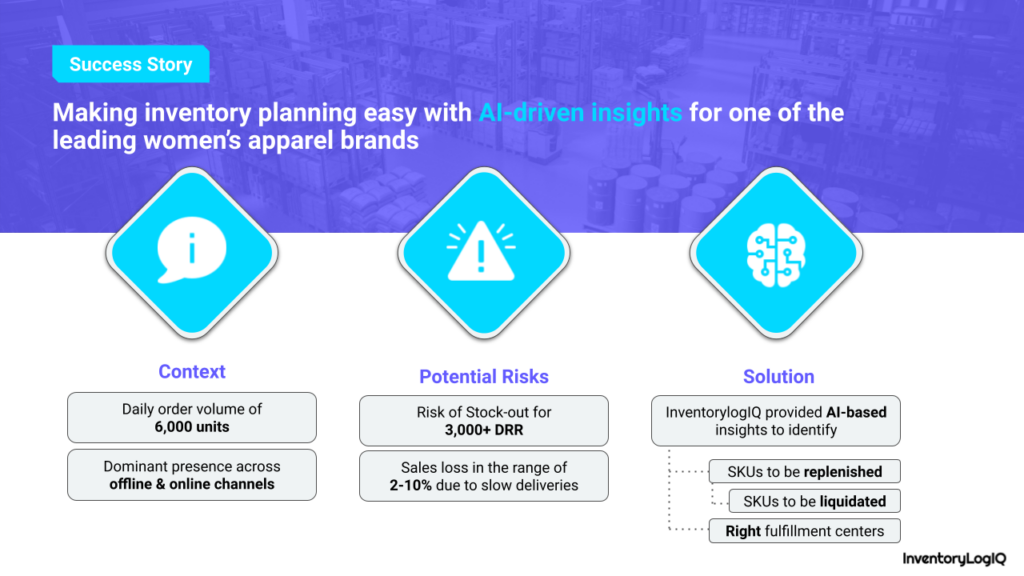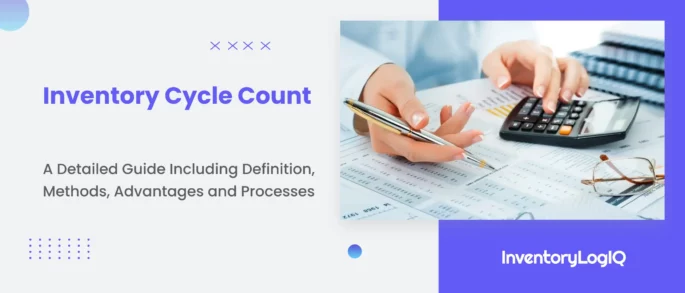What is Inventory Accuracy? Importance, Formula, Challenges, and Strategies to Achieve High Inventory Accuracy for Operational Efficiency in 2022
Inventory is one of the key aspects of an eCommerce business. It is what allows them to make sales and generate revenue. Because of this, inventory management should be handled with utter care and in the most efficient way possible. One of the main ways that a business can understand more about its inventory is by measuring its inventory accuracy. This allows retailers to understand how accurately their supply chain processes really are. In this blog, we will get a clear understanding of accurate inventory, its importance and how InventoryLogIQ can help increase it. Read along.
- What is Inventory Accuracy?
- Inventory Accuracy Formula Used in Calculations
- Why is Attaining a High Level of Inventory Accuracy of >99% Important for Operational Efficiency?
- 3 Reasons Why eCommerce Businesses Struggle to Maintain Inventory Accuracy
- 5 Strategies to Increase Inventory Accuracy by Using an Inventory Planning Software like InventoryLogIQ and a 3PL like WareIQ
- Conclusion
- Inventory Accuracy: FAQs
What is Inventory Accuracy?
A metric that measures the difference between your warehouse records and your actual stock is known as inventory accuracy. Keeping track of inventory accuracy is critical in order to prevent stockouts, shortages, and inventory shrinkage and control inventory quality, maintain happy customers and give them a great shopping experience.
Any issues in maintaining inventory accuracy can cause massive problems in your supply chain. Your supply chain can suffer when there are inaccuracies in your inventory records. A registered product that does not exist might be sold. Your records may show plenty of stock when there’s could be practically no stock in the warehouse. This is why it is imperative to place importance on inventory accuracy.
Inventory Accuracy Formula Used in Calculations
To calculate inventory accuracy using the inventory accuracy formula, count the number of items currently in stock, divide it by the stock count on file and multiply by 100. The result will be your inventory accuracy rate. However, before calculating your inventory accuracy rate and using it as a KPI, make sure that you have a reliable manual count to compare your inventory records with. The count must meet the following requirements:
- Multiple employees must perform and confirm the count or it can be done through inventory management software which reduces the possibility of human error.
- The count is done meticulously over several days with a focus on accuracy and an emphasis on precision.
Here is the inventory accuracy formula:
Counted units/Units on record X 100 = Inventory accuracy rate
The average inventory accuracy for businesses while using the inventory accuracy formula is between 65% and 75%. This covers businesses that manage inventory using SKUs and barcode scanning. However, such a low (or even lower) percentage is bad for the company.
Most organizations that want to enhance their inventory management should aim for a score of 97% or higher.
Why is Attaining a High Level of Inventory Accuracy of >99% Important for Operational Efficiency?
Your inventory records must reflect your actual inventory in order to run an efficient business and optimize your inventory. If you don’t, you could risk the following consequences:
Customers Can be Lost if Product Orders are Delayed
If their delivery is delayed for more than two days, the majority of clients will not shop with that business again. It could take weeks for a consumer to receive a box if they order a product that exists in the database but not in the warehouse. Imagine how the person will react to a much longer delay. Keeping accurate inventory counts will help avoid stockouts like these in the future.
Inventory That Has Not Been Registered Will Not be Sold
A business almost certainly has merchandise that isn’t on the books. This inventory will not be able to be sold or moved. Sales of a product will be significantly slowed, and inventory may be hampered as a result. From order fulfillment to inventory stock control, every process will be affected badly. Customers can be lost if product orders are delayed. Every business is aware of this fact.
Overstocking and Additional Holding Expenses Can Occur
Bad recordkeeping can lead to unwise judgments, such as purchasing too many inventory goods based on inaccurate consumption data. This will result in excess inventory, higher carrying costs, and unsellable items filling the warehouses. Accurate digital records are required for a successful inventory procedure. If not, it’ll be tough to keep track of actual stock levels. Real-time tracking is a good solution along with WMS (Warehouse Management System), which uses barcoding and RFID to track arriving and outgoing items in real-time. Every delivered or received item in the warehouse is scanned swiftly and added or removed from the system automatically. Human errors are greatly reduced through automation. Instead of manually entering data for new shipments, everything is automatically uploaded to the records.
3 Reasons Why eCommerce Businesses Struggle to Maintain Inventory Accuracy
Many businesses struggle to maintain inventory accuracy for the 3 following reasons:
- Fulfilling orders directly
- Lack of proper inventory management
- Use of outdated technology
Fulfilling Orders Directly
Many eCommerce retailers desire to be as self-sufficient and cost-effective as possible by taking care of the entire process of inventory management and order fulfillment on their own. When inventory is not professionally stored or handled at a warehouse, it might result in inventory accuracy issues.
Without the proper equipment and a devoted, skilled workforce, inventory storage becomes increasingly difficult as the company grows and expands its range of products and services which leads to lower inventory accuracy.
A business can track inventory on paper or spreadsheets if its inventory management system is sub-standard or non-existent. However, this inventory accuracy formula won’t be very tenable for long. Integrating with an advanced inventory management software makes it easier to keep inventory records up to date, simplifies accounting processes, prevents stockouts, and expedites manufacturer purchases.
Lack of Proper Inventory Management
Without proper inventory management, the entire supply chain process suffers, including picking, packing, and shipping. If inventory accuracy is not maintained, the wrong product could easily be picked, which means that the order is destined to fail from the beginning. This will then have a spiral effect on processes further down the supply chain until it finally reaches the customer, who will be furious that they have received the wrong product and will initiate an RTO request, which will cost the company even more money.
In a similar way, if there isn’t a concise process available, the driver could easily drop off the wrong product to the customer. To mitigate all these issues, retailers need to invest in getting as close to a 100% inventory accuracy rate as possible.
One way to remove the threat of driver error is to install shipping apps where the logistics company can give routes to drivers automatically. With the push of a button, drivers can access the order list and obtain directions. There’s no chance that they’ll mistype or misinterpret an address.
One may also track drivers’ movements and deliveries in real-time through the app. When the driver arrives at an address, the app will immediately reflect if the package has been successfully delivered or not. The software then sends this information to the dashboard, along with the user’s current GPS location. Hence, the app shows the status of all deliveries, including ETAs and expected delays.
Use of Outdated Technology
Most inventory accuracy happens at the warehouse and the only way to reduce problems that may arise at the source is to invest in good inventory management software to take care of updating and keeping track of inventory.
Companies that rely on old and manual methods of tabulating inventory levels and updating inventory every time an order is placed are bound to make more miscalculations than firms that employ advanced inventory management software to maintain a high level of inventory accuracy. The use of technology instantly makes any manual mistakes and errors redundant and results in an impressive inventory accuracy rate of over 99%.
Comprehensive analytics addresses issues such as faulty or delayed delivery. If there is a problem with a certain week, day, or depot, one can investigate the information to discover the source of the problem causing issues.
5 Strategies to Increase Inventory Accuracy by Using an Inventory Planning Software like InventoryLogIQ and a 3PL like WareIQ
Optimizing Warehousing Processes
If a business wants to scale up sustainably, it needs a solid warehouse management system. Traditional warehousing systems are simple, prone to errors and lack the functionality firms need to succeed in today’s eCommerce environment. However, investing in a functional WMS can help you to optimize warehousing processes and make the entire operation more efficient.
The new and improved modern warehouse management systems can assist in the following ways:
- Makes sure a business is never under or overstocked
- Maintains inventory levels down to each item
- Syncs inventory across all sales channels
- Compiles inventory data in real-time, in order to generate data-driven insights and provide accurate inventory data
Concise Labeling of Inventory
In addition to labeling actual products, one must also mark the storage location for each item. Sections, rows and shelf numbers must all be included in the label, in addition to important information about the product itself. If a company has a large storage area, it’s a good idea to assign zone numbers or even room numbers, if necessary. The following points can help you to accurately label your inventory to achieve higher inventory accuracy:
- Empty storage spaces should not be overlooked. Even if a section is not being used for storage right now, it should still be named for future usage. This saves time and eliminates the possibility of inconsistencies in the labeling scheme.
- Labels should be easy to read. The text colour should contrast with the label colour to make it more readable.
- To minimize misinterpretation, no apparent reference labels can be the same. Include arrows pointing to objects the label refers to, which is especially handy when shelves are layered.
- Maintain consistency in labeling by using letters and numbers (sometimes both) consistently and in the same order throughout. Start at the top, for example, A or 1, and move down.
- Each item comes with its own description. A label’s name should begin with the item’s name (a noun).
- If all item labels begin with the colour of an item, then searching and tracking will be difficult.
- The item should then be described with adjectives. Start with the most crucial descriptive term. When labeling products, make sure that you keep them in accordance with these guidelines.
- Print out photos or photographs of the products inside plain or assorted boxes to help you determine products without having to open them.
- On the label, only provide information that will assist in identifying and locating the objects.
- When adding size, measurements or weight to an item’s description, attempt to use abbreviations that everyone understands and in lower case letters.
- To boost your efficiency, identify your products and storage areas in a realistic, concise, and organized manner.
Clear Internal Policies
Clear internal policies necessitate the establishment of quality standards and policies for employees to follow. Here are some tips to create clear internal policies to increase your inventory accuracy:
- Choose Management Quality Control Techniques: Inventory control is only one aspect of improving inventory management. With a management approach that workers can commit to, you can enhance business operations from the ground up. Using Kaizen, Lean and Six Sigma are just a few examples.
- Optimize Purchasing Procedures: Using data and forecasting to regulate purchasing procedures is one of the trademarks of good inventory management and clear internal policy. Identifying metrics by monitoring consumer demand, removing obsolete stock, adjusting safety stock and reorder points are all parts of this process.
- Manage Supplier Relationships: Managing supply chain relationships correctly is crucial since working closely with suppliers may often prevent and fix problems. Suppliers, for example, can offer your company a negotiated minimum order size, take back things that aren’t selling and assist you in fast restocking when sales for a given item pick up.
- Create Automated Reports: Because stock control and management systems generate massive amounts of data, companies must figure out where to evaluate, report, and how to use it. Inventory status, stock logs, reconciliation, historical stock, aging inventory, and inventory financials are all reports that many systems create automatically. Furthermore, firms should select where in their supply chain this information should be used so that suppliers can effectively prepare.
- Perform a Risk Analysis: Whether you have an unanticipated sales increase, a cash shortfall, insufficient storage facilities, a stock underestimation, and slow-moving or discontinued products, problems will inevitably arise. Make a risk matrix to figure out what your biggest threats are or how to deal with them if they arise.
- Audit on a Regular Basis: This is to ensure that your real stock and reports are in sync. Physical items, spot-checking and cycle counting are the three methods for conducting an audit. Physical inventory entails counting all of your stock and it should be done at least once a year and more frequently near the end of the year to coincide with taxation reports. Checking for flaws on the spot is a good idea.
- Forecast Inventory: Use techniques such as ABC analysis and other inventory forecasting techniques.
Accurate Counting Per Cycle
Cycle counting is the technique of counting items in parts on a regular basis in order to keep track of stock levels without disrupting normal operations. This method entails breaking down the stock in warehouses into smaller groupings of products that need to be counted. This segmentation could be based on a variety of factors, including the product category, manufacturer, warehouse location and so on. When using a good inventory management system, segmentation becomes simple.
However, for the greatest cycle count results, it is recommended that two unique segments are created:
- High-risk counts: These are groups of products that have had the most inventory discrepancies, errors or inventory write-offs in the past.
- High-value counts: These are product groups with the highest cost or sales potential. Because these are the most expensive items, it is critical to keep accurate track of them.
Utilise Technology for Inventory Management
Inventory management software like InventoryLogIQ that is up to current standards can have a significant impact on improving inventory accuracy. Inventory management software includes everything you need, including an intuitive user interface, efficient order administration, precise stock management, and real-time inventory insights.
Here’s what it can do for an eCommerce business:
- Tracks inventory in real-time and reconciles at the SKU level.
- Analyzes previous sales trends, predicts demand and suggests the appropriate inventory levels accordingly.
- Sets a reorder threshold to prevent stockouts by automatically replenishing goods.
Conclusion
Maintaining inventory accuracy is a key component of the success of a business in today’s day and age. It reduces the number of errors that could occur further down the supply chain and ensures that customers receive accurate orders so that they will have a positive opinion about your business. As discussed above, there are many ways to achieve a high level of inventory accuracy, if you require assistance with inventory accuracy and any other eCommerce-related processes, you can check out Inventory LogIQ.

InventoryLogIQ can help your business achieve an accuracy rate of more than 99% with our state-of-the-art IMS that assists in accurate inventory management and efficient regional utilisation.





